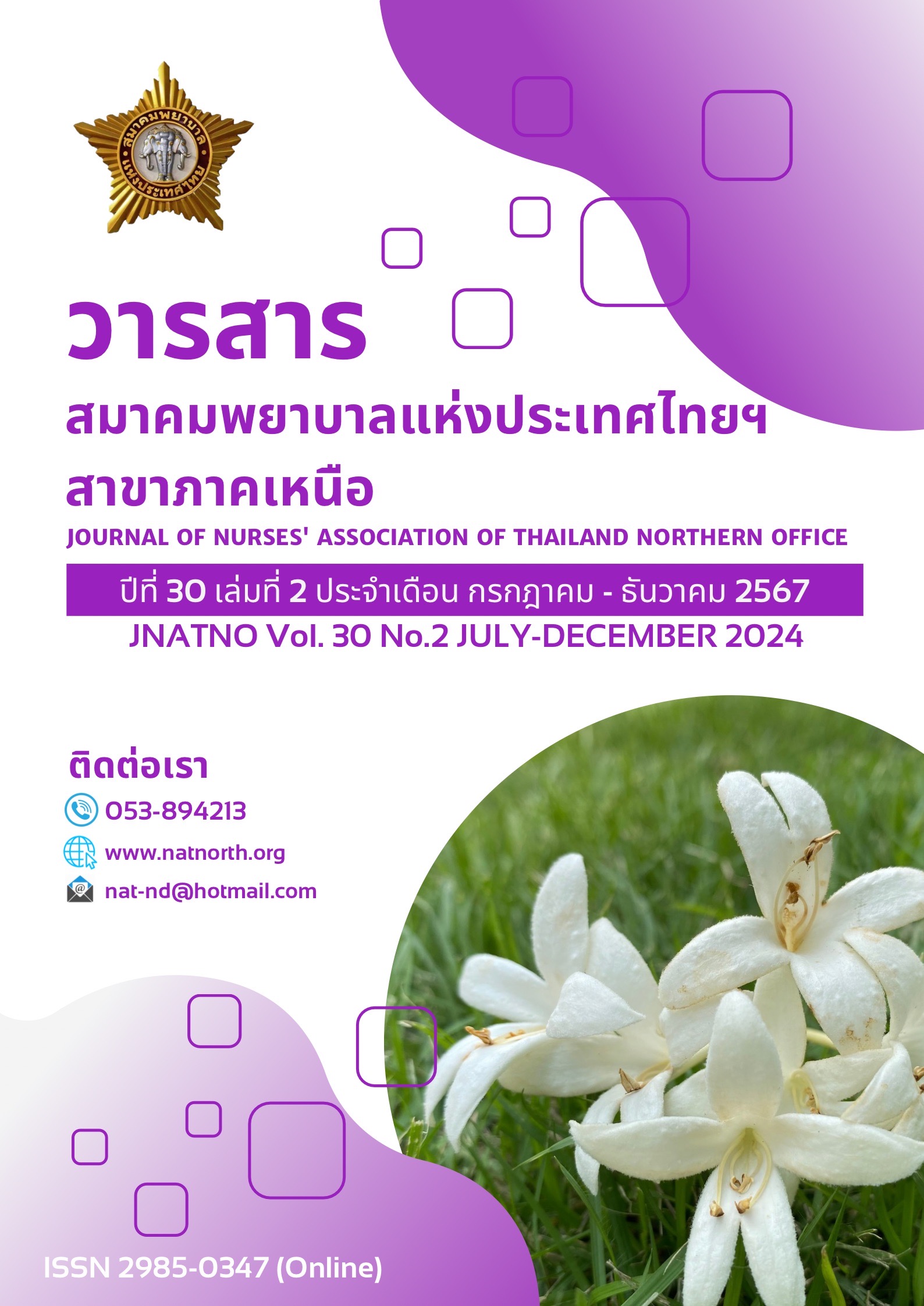Development of a Telephone Triage and Criteria-Based Dispatch System for Acute Ischemic Stroke Patients of the Emergency Medical Service Call Center, Phrae Province
Keywords:
Acute ischemic stroke, telephone triage, dispatch system, emergency medical service call centerAbstract
This study aimed to develop a telephone triage and task allocation system for patients with acute ischemic stroke at the in the Emergency Medical Dispatch Center, Phrae Province. The research process consisted of three steps: 1) analyzing the situation of stroke patient emergency calls over the past six months and conducting focus group discussions for in-depth data collection; 2) developing a telephone triage and dispatch system based on the findings from step one; and 3) testing the effectiveness of the developed system. The purposive sample included 11 personnel and 60 patients, and were assigned to control and experimental group. Each group consisted of 30 participants. Data were collected before and after the use of the triage guidelines. General data of the sample groups were analyzed using descriptive statistics, while differences between the control and experimental groups were compared using dependent t-test, independent t-test and Wilcoxon Rank sum test.
The results showed that: 1) the accuracy of telephone triage for acute ischemic stroke patients was improved after the system development; 2) the developed triage and dispatch system demonstrated high reliability, with a Content Validity Index of 0.98; 3) personnel knowledge was significantly increased after training (p < 0.01), and the rate of correct triage and dispatch was increased from 83.3% to 100% (p = 0.05); and 4) personnel satisfaction with the practice was at a very high level (mean = 4.71, SD = 0.44), with the increased rate of the stroke fast-track access from 33.3% to 63.3% (p = 0.04) and the increased rate of the rt-PA administration from 3.3% to 10%, with an average door-to-needle time of 68 minutes.
Conclusion, the telephone triage and criteria-based dispatch system for acute ischemic stroke patients which has been developed in this study can be used at the emergency medical service center with a similar context to the research. It was suggested that there should be a training and communicate with the user to gain proper understandings before using this system.
References
French BR, Boddepalli RS, Govindarajan R. Acute ischemic stroke: current status and future directions. Mo Med. 2016;113(6):480-6.
Jauch EC, Saver JL, Adams HP, Jr., Bruno A, Connors JJ, Demaerschalk BM, et al. Guidelines for the early management of patients with acute ischemic stroke: a guideline for healthcare professionals from the American Heart Association/American Stroke Association. Stroke. 2013;44(3):870-947.
Suwanwela NC. Stroke epidemiology in Thailand. J Stroke. 2014;16(1):1-7.
Powers WJ, Derdeyn CP, Biller J, Coffey CS, Hoh BL, Jauch EC, et al. 2015 American heart association/american stroke association focused update of the 2013 guidelines for the early management of patients with acute ischemic stroke regarding endovascular treatment. Stroke. 2015;46(10):3020-35.
Saver J. Time is brain - quantified. stroke. 2006;37:263-6.
Benner P. From novice to expert: excellence and power in clinical nursing practice. AJN. 1984;84:1480.
Styles M, Schafheutle E, Willis S, Shaw M. Pharmacy professionals’ perceptions of educational supervision in primary care through the lens of Proctor’s model. BMC Medical Education. 2023;23.
Soukup SM. The center for advanced nursing practice evidence-based practice model: promoting the scholarship of practice. Nurs Clin North Am. 2000;35(2):301-9.
Gardner G, Gardner A, O'Connell J. Using the donabedian framework to examine the quality and safety of nursing service innovation. J Clin Nurs. 2014;23(1-2):145-55.
สมศักดิ์ เทียมเก่า. อุบัติการณ์ โรคหลอดเลือดสมอง ประเทศไทย. วารสารประสาทวิทยาแห่งประเทศไทย. 2566;39(2):39-46.
วันเพ็ญ ปลั่งเนียม, เอื้องอรุณ สรโยธิน, อังสินี กันสุขเจริญ. การรับรู้และการตัดสินใจเข้ารับการรักษาของผู้ป่วยโรคหลอดเลือดสมอง. วารสารพยาบาลศาสตร์. 2566;12(1):45-52.
ปุยนุช รักซื่อ และสิริกัลยา พูนผล. ปัจจัยที่สัมพันธ์ต่อความล่าช้าในการมาโรงพยาบาลของผู้ป่วยโรคหลอดเลือดสมองเฉียบพลันในโรงพยาบาลพาน. วารสารระบบบริการปฐมภูมิและเวชศาสตร์ครอบครัว. 2566;6(2):167-78.
นันทวรรณ ทิพยเนตร. แนวปฏิบัติการรับแจ้งและจ่ายงานสำหรับโรคหลอดเลือดสมอง. วารสารการแพทย์ฉุกเฉิน. 2564;8(3):200-6.
Puyhuaton Y. Triage system in chiang mai neurological Hospital. J NAT North [Internet]. 2021 Dec. 29 [cited 2024 Nov. 5];27(2):69-83. Available from: https://he01.tci-thaijo.org/index.php/jnorthnurse/article/view/252283.
Downloads
Published
How to Cite
Issue
Section
License
Copyright (c) 2024 Nurse' Association of Thailand Northern Office

This work is licensed under a Creative Commons Attribution-NonCommercial-NoDerivatives 4.0 International License.
บทความที่ได้รับการตีพิมพ์เป็นลิขสิทธิ์ของสมาคมพยาบาลแห่งประเทศไทยฯ สาขาภาคเหนือ
เนื้อหาและข้อคิดเห็นใดๆ ที่ตีพิมพ์ในวารสารสมาคมพยาบาลฯ ถือเป็นความรับผิดชอบของผู้เขียนเท่านั้น ผู้เขียนบทความต้องศึกษารายละเอียดหลักเกณฑ์การจัดทำต้นฉบับตามที่วารสารกำหนด และเนื้อหาส่วนภาษาอังกฤษต้องได้รับการตรวจสอบจากเจ้าของภาษามาแล้ว


